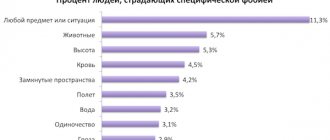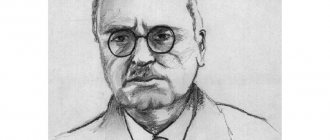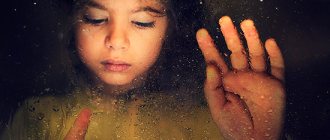Phobia concept
The concept of “phobia” is well known to everyone, but not everyone can coherently explain what exactly it is. Translated from Greek, “phobia” means “fear, fear.” In reality, fears and phobias are very close, but there are significant differences between them. Fear is a natural protective function of the body in the face of real danger, physiologically manifested in the release of hormones into the blood, rapid heartbeat, autonomic dysfunction, etc. An interesting fact can help to understand the nature of fear - a person is born absolutely fearless. Little children are not afraid of falling from a height, drowning in the bathtub, or touching fire with their finger. Only later does the feeling of fear come with experience, and, basically, these fears are useful. Basically, the feeling of such fear helps to escape from dangerous situations or prevent them. This feeling of fear is completely conscious and controlled by common sense and logic. Phobias are fears that are characterized by very significant stability, are not based on common sense (irrational) and are constantly present in the human psyche. Moreover, these fears most often are not of a real threat, but fears “within us.” Phobias, unlike fears, are very difficult to control by thinking and common sense.
Biological meaning of fear
In order to penetrate deeper into the essence of such a phenomenon as a phobia, we need to understand what fear is and why we need it.
Fear is an emotion that is caused by the instinct of self-preservation. We need it in order to be able to recognize a real threat to our lives. That is, fear is an emotion that is objectified by something specific that can cause specific damage to a person’s life, health or well-being.
And from a situation in which we experience fear, there are two main ways out: fight or flight.
For example, an angry dog barks at us and because of this we feel fear. If the dog is small, then we can shout to it: “Get out of here!” or even emotionally kick her aside. She will whine and run away. This is the “fight” reaction. And if this is an impressively sized dog, such as a shepherd or a Rottweiler, then we will begin to back away in fear, trying to find some kind of fence with a gate to isolate ourselves from the evil dog. This is the “flight” response.
But let's consider another situation in which the same Rottweiler or Shepherd does not pay attention to us, since the owner is walking them, clutching a leash in a strong hand. And at the same time the dog is wearing a muzzle. Will we experience fear in this situation? I think that most sensible people will not experience fear. And why? Because in this situation there is no threat to life. The situation is under control.
But if a person has a phobic fear of dogs, he will experience fear even in a situation where the dog is on a leash and muzzle.
If we ask him why he feels fear when the dog cannot attack him, he will say: “After all, it can twitch and snatch the leash from the owner’s hands, attack us and tear us up with its claws, or somehow throw off the muzzle and bite us. Who knows what to expect from dogs, they are animals after all!”
It becomes clear that fear is something rational, and phobic fear is something that cannot be rationally explained. After all, if you think about it, anything in the world at any moment in time can go wrong as planned and thereby cause harm to anyone. But nevertheless, this person we are considering is afraid of being injured by a dog. Most people do not constantly think about what might threaten them in this world, since such anxiety would prevent them from functioning effectively in society: going to work, performing everyday activities, taking care of their family and home. You can’t foresee everything, and therefore there will always be an element of unpredictability in a person’s life.
How to distinguish a phobia from “simple” fear
Let's look at the difference between fear and phobia using a real example.
There are a sufficient number of people who are afraid to travel in the subway. If the cause of fear is fear, it must be caused by certain negative experiences in the past. For example, a person once felt ill on the subway. If the reason is fear, then the person will prefer to move around the city by ground transport, but if the need arises, he will still go down to the metro. Naturally, this will be accompanied by certain experiences, but will be controlled by common sense and logical thinking. In the case of a phobia, the problems will be much more significant, depending on the severity of the phobia. In the mildest cases, a person will still go down to the subway, but any, even the most insignificant, stops of the car between stations will cause a pre-panic and panic state. In the most severe cases, a person will not be able to force himself to go down to the subway even in case of emergency, contrary to logic and common sense, and any attempts to force this by other people can cause severe psychological trauma. Is this relevant? According to world statistics, every eighth inhabitant of planet Earth has phobias. Thus, phobias, as a type of neurotic disorders (Neuroses, depression, fears) are a widespread phenomenon.
Alarm level
We come to another important concept - anxiety . Anxiety plays a key role in phobic disorders.
If fear is an emotion that concerns a specific threat to life, then anxiety arises when, in fact, there is nothing to be afraid of. Anxiety, to put it simply, is unformed fear. A person is afraid of something, but what exactly is unknown. He seems to be in anticipation that something will happen soon that could cause him harm. But whether this will actually happen or will never happen is unknown.
Anxiety levels may be normal, elevated, or decreased. We will focus primarily on the first two types.
Normal level of anxiety
Anxiety, in itself, like fear, has a useful function that protects a person. If a person does not feel anxiety at all, then he will not be able to soberly assess his capabilities. He will be careless and will constantly run into trouble. Anxiety helps us anticipate situations in which we might experience fear. In other words, anxiety is our caution and prudence. A moderately cautious person can achieve a lot. A careless person will constantly find troubles on his head and will not have the internal resource to get out of them, since this will require forethought, which he does not possess. A person who is overly cautious will, on the contrary, be overly afraid of everything.
Increased level of anxiety
This type of anxiety is characterized by the fact that a person expects danger everywhere. He is constantly afraid, but does not know what. Such a person is inclined to draw conclusions based on a single case. For example, a person got stuck in an elevator and after that began to ride them less often. Then, after a while, he got stuck again and after that he saw on the news how an elevator cable broke in some house in his city, as a result of which people died in the fallen elevator.
Such a sequence of events may be sufficient to form a phobia, provided that the person initially had a high level of anxiety.
For a person with a normal level of anxiety, in order to form a stable avoidance of something, more extensive statistics must accumulate.
Formation of a high level of anxiety
As can be seen from the previous chapter, a high level of anxiety is required to form a phobia. But how does it happen that an excess of anxiety is formed in a person?
Like most other psychological traits, anxiety begins in childhood. Let's say a child lived in a family in which the father could at any moment burst into sudden screams, the reason for which was not clear to this child. And it was unknown how the father’s screams would end: either he would calm down and cool down, or it would come to assault and which of the family members would suffer.
The child lived in a state of constant readiness for danger. He always remained on guard, and this created excessive anxiety in him.
The reason why a person becomes anxious and tense may be different, but the essence will always be that as a child, he was always in anticipation of some specific danger and this emotional state became familiar to him. And when such a person matured, this emotional state, entrenched in the psyche, remained with him.
Types of phobias. Classification of phobias
Currently, more than 500 types of phobias have been described. The most common of these are social phobia and agoraphobia.
- Social phobia is a type of phobia that is characterized by a pronounced fear of being the center of attention of strangers, or of behaving in a way that will cause humiliation or embarrassment. This type of phobia manifests itself in social everyday situations - during a meeting with friends, lunch in a cafe, the need to speak at a meeting, and others.
- Agoraphobia is a type of phobia associated with “helplessness if things suddenly become bad.” This type of phobia manifests itself in the fear of traveling unaccompanied or being among strangers.
All other types of phobias are classified into the group of so-called isolated phobias.
Below are examples of just a few of them. Phobias of animals or insects:
- - cynophobia - fear of dogs;
- - Gatophobia - fear of cats;
- - arachnophobia - fear of spiders;
- - ophidophobia - fear of snakes.
Phobias associated with situations:
- - claustrophobia - fear of closed spaces;
- - ochlophobia - fear of crowded places;
- - monophobia - fear of being alone with oneself;
- - xenophobia - fear of foreigners, strangers.
Phobias associated with natural forces:
- - acrophobia - fear of heights;
- - nyctophobia - fear of darkness, night;
- - aquaphobia - fear of water;
- - pyrophobia - fear of fire;
- - thalassophobia - fear of the sea.
Health-related phobias:
- — odontophobia – fear of dental treatment;
- - bacillophobia - fear of microorganisms;
- - Cardiophobia - fear of cardiovascular diseases;
- - Hematophobia - fear of the sight of blood.
Phobias associated with conditions and actions:
- - stasibasiphobia - fear of an upright position and walking;
- - stasyphobia - fear of standing;
- - lalophobia - fear of speaking;
- - tremophobia - fear of trembling;
- - Basilophobia - fear of walking;
- - amaxophobia - fear of traveling in public transport.
Phobias associated with objects:
- - hyalophobia - fear of glass;
- - macrophobia - fear of large objects;
- - microphobia - fear of small objects;
- - computerphobia - fear of computers;
- - Belonephobia - fear of piercing objects.
Contact a specialist
Sign up for a consultation tel. 242-82-65
Make an appointment
Yuri Lvovich Muchnik
Psychiatrist-narcologist
Doctor of the highest category. 35 years of experience. Works at the Clinic named after. prof. F.F. Preobrazhensky since 2001
Formation of a phobia based on an increased level of anxiety
When a person is constantly tense and anxious, he subconsciously wants to somehow realize his anxiety. And if a convenient moment comes up, anxiety, being, as we found out, pointless, becomes objectified, choosing as an object, for example, trips on the subway or flights on an airplane. The person immediately finds many pseudological justifications for why it is dangerous to ride the subway or fly on an airplane and will sincerely believe in them.
It is worth noting that a phobia can form either as a result of some incident or almost out of the blue. But one thing will be unconditional - the level of anxiety of the owner of the phobia will be high.
What symptoms accompany phobias?
The state of panic is accompanied by vegetative disorders:
- increased heart rate;
- increased sweating;
- lack of oxygen;
- state of horror.
How does a phobia manifest itself emotionally?
A person experiences self-doubt, strong tension, prompting him to quickly escape, seek salvation and protection.










